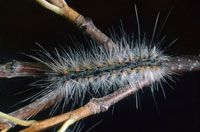Hyphantria cunea
Hosts
Apple, Ash, Cherry, Elm, Maple, Willow and other trees and shrubs

Photo credit: Thérèse Arcand, Natural Resources Canada
Appearance and Life Cycle
The fall webworm overwinters in the pupal stage. In late June to early July moths emerge. Adult moths are white with reddish-orange front legs and have a wingspan of 30 to 40 millimetres (mm). After mating, the females deposit 200 to 300 round, white to golden-yellow eggs on the undersides of the leaves. Within two weeks, larvae emerge from the eggs and feed on the host for six to eight weeks. Full grown larvae are approximately 25 mm in length and have pale yellowish-brown bodies with broad, dark bands down the backs. Long, whitish hairs protrude from black and orange impressions along the larvae bodies. In September, larvae drop to the ground and burrow into the litter and soil, constructing cocoons in which they pupate, completing their life cycle.
Damage
Larvae of the fall webworm feed as a colony within nests constructed of webbing. At first, the larvae only skeletonize the leaves. Later as the larvae develop, the leaves are devoured entirely. During severe outbreaks, some trees may be completely defoliated. The large nests of webbing containing excrement, cast larval skins and dried leaf fragments are extremely unsightly. In the prairies, minimal damage results, because the attacks occur late in the growing season.

Photo credit: Penn State University, woodypests.cas.psu.edu
Control
Damage by the fall webworm can be reduced by removing and destroying the larvae-infested nests. Chemical control is rarely required but may be achieved using: Bacillus thuringiensis; carbaryl; diazinon; malathion or methoxychlor. Sprays should be applied with sufficient pressure to penetrate through the webbing.